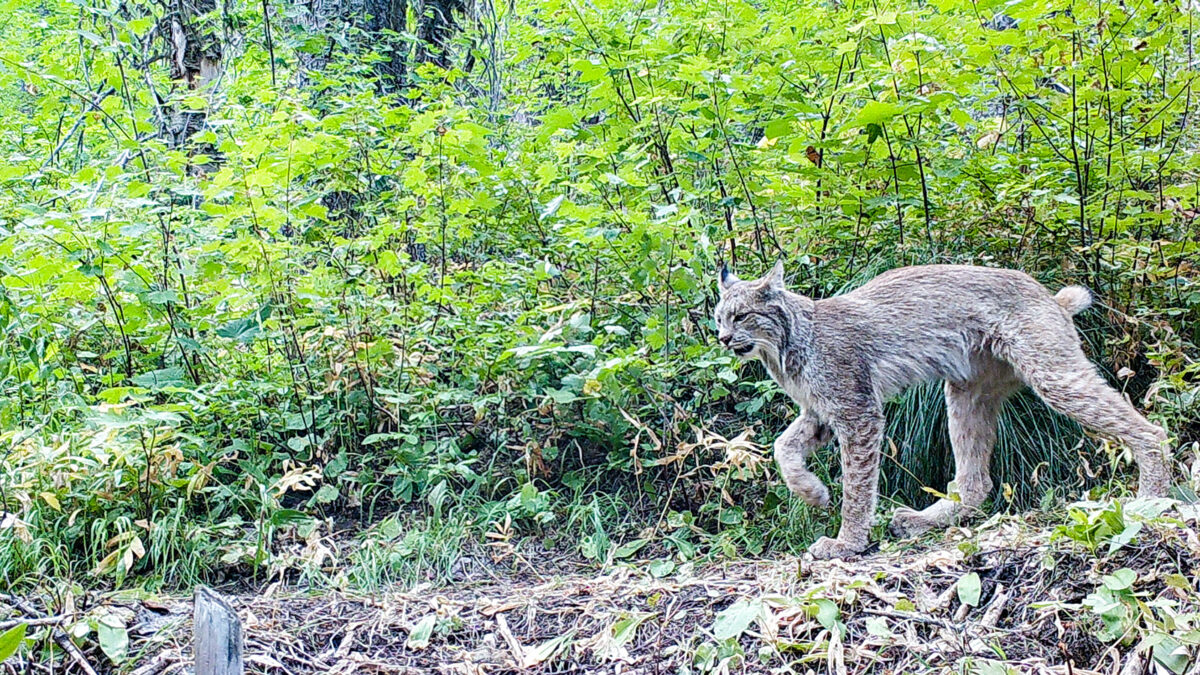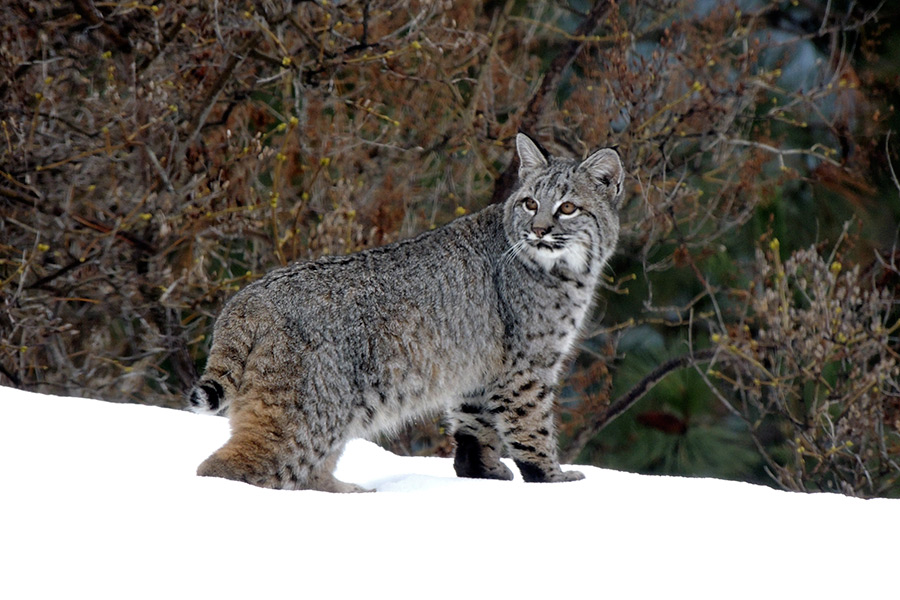The Complicated Case of the Captured Canada Lynx
Two threatened lynx were accidentally captured by bobcat trappers in northwest Montana, resulting in one mortality and a state citation. The case has drawn attention to an obscure set of regulations that anti-trapping organizations say runs counter to the conservation mission.
By Tristan Scott
Due to Montana’s participation in an international pelt export program, wildlife management officials have adopted exceptions for bobcat and wolf trappers whose legally set trap lines result in the “incidental take” of endangered Canada lynx, with separate allowances and guidelines surrounding the trapping seasons for both wolves and bobcat.
It’s a complex arrangement between state and federal wildlife managers that doesn’t get much attention, but which is regulated under the Convention on International Trade in Endangered Species (CITES).
Essentially, the U.S. Fish and Wildlife Service (USFWS) has established an allowable incidental take for lynx in the lower 48 states. The concept of “allowable take” acknowledges that in states with bobcat trapping seasons, some incidental capture of lynx is possible. With “allowable take,” the USFWS establishes a number of incidental captures that would be “allowable” and still provide for the conservation of the species, which in the contiguous United States was listed as threatened under the Endangered Species Act in 2000.
And while debate has swirled around the state wildlife commission’s decision to lengthen the 2023-24 wolf trapping season by over a month, with litigants successfully challenging the extended season on the grounds that it increases the likelihood of incidental captures involving grizzly bear cubs, it’s rare that the bobcat trapping season results in the allowable take of Canada lynx.

But last month, the issue reared its head for the first time in more than a decade when not just one but two lynx were captured in rigs set for bobcat, and while one of the critters was released uninjured, the other animal died. Because the trap that resulted in the killed lynx was an illegal set, the trapper was issued a citation by a Montana Fish, Wildlife and Parks game warden, and the death won’t count toward the state’s “allowable take” tally because, well, it wasn’t allowable.
“This gets complicated, but under CITES, Montana has a permit that allows for legal bobcat trapping in Montana and for legally harvested furs to be sold. And under that permit is this allowable take for lynx killed or captured in legally set traps,” explained Greg Lemon, FWP’s statewide communication and education division administrator. “That allowance is for six captured and released bobcats and/or three killed bobcats within a three-year window in the lower 48. And that is in legally set bobcat traps. We believe that the bobcat trap that killed the lynx was an illegal set, so it won’t count toward the allowable take total.”
Lemon said the last incidental lynx captured before the two in December was back in 2013. He said data on whether that incident involved a lynx that was killed or released was not available.
Allowable take of lynx in the lower 48 states is six trapped/captured or three killed/captured as a result of legal bobcat trapping within three consecutive years. The state of Maine operates under its own allowable take permit and so is not included in the remaining lower 48 states. Recently, a lynx in Minnesota was killed in a trap, and two lynx were trapped in Idaho but were released during the 2021 trapping season. Under that arithmetic, and excluding the recent death in Montana, the current number of lynx incidentally trapped in legal sets stands at four captured and one killed in the three-year window.
If the allowable take number is met, the USFWS would initiate a review to ensure conservation of the species.
On Jan. 8, the Beacon submitted a public records request to obtain a copy of the citation issued to the trapper by FWP, which Gail Eblen, FWP’s public records team lead, said can take up to 30 days to fulfill. The citation was filed in Flathead County Justice Court, but without a case number, the name of the game warden that issued the citation or the violator’s name and date of birth — information that FWP declined to provide — court officials could not fulfill the Beacon’s request for the records.
According to Lemon, both captures were self-reported to state wildlife officials and occurred in a lynx protection zone in the Flathead Valley; however, the illegal set that killed the lynx and resulted in a citation was a technical violation. Traps set using an anchor chain greater than 12 inches in length are required to have a “swivel” attached at the trap and another attached within 12 inches of the trap, a requirement aimed at reducing the risk of injury or death to a captured critter writhing in a trap.
The FWP warden issued a citation to the trapper because the configuration of the set was missing one of the swivels, Lemon said.
“With the two swivels, an animal can rotate and rotate and rotate and the anchor chain isn’t likely to bind up and cause injury,” Lemon said. “But that wasn’t the case here.”

In the 2023 Wolf and Furbearer Regulations, the state wildlife commission recognized lynx protection zones and special restrictions for trapping within those zones to minimize incidental capture of lynx. Trappers who inadvertently capture a lynx must release it unharmed if possible and report it to FWP within 24 hours, or if it’s wounded contact FWP immediately to “determine disposition and/or collection of the animal.”
Montana also has specific trapping regulations to reduce the potential capture of lynx. For example: Lynx protection zones (LPZ) prohibit wolf snaring on public lands; wolf foothold traps in Regions 1 through 5 are required to have a minimum of 10 pounds of pan tension; no natural feathers or pieces of fur can be used in the LPZs so that lynx are not visually attracted to the set intended for another species; bobcat and wolf traps set in the LPZs are required to be checked every 48 hours. Regulations for conibear traps are also more restrictive in the LPZs to mitigate the potential of catching a lynx, and all snares in the LPZs are required to have a relaxing lock, which decreases the lethality of the device.
“We are dedicated to and have demonstrated dedication to the conservation and protection of lynx in particular, and those CITES rules are there for a reason,” Lemon said. “We want to keep a close eye on what’s happening so that if things change we can go to the commission to look for a course adjustment or changes that are needed to stay within the rules and protect lynx.”
But critics of “allowable take” say those rules shouldn’t be at play on landscapes where threatened and endangered species like lynx occupy large chunks of habitat.
“When the USFWS is allowing incidental take, they are allowing the hunting of lynx,” said Jessica Karjala, executive director of Footloose Montana, a nonprofit organization that opposes trapping. “Why claim to protect a species if incidental take is allowed? The USFWS have no real way of monitoring traps and trapping, so there is no telling how many lynx are being killed by traps and/or not reported. In a similar manner, Montana FWP can claim they are ‘watching the circumstance very closely’ but it’s lip service. Trapping is indiscriminate and kills animals in the most cruel way – by design. The bottom line is that when the USFS allows incidental take and the FWS allow self-reporting, lynx are not being protected.”